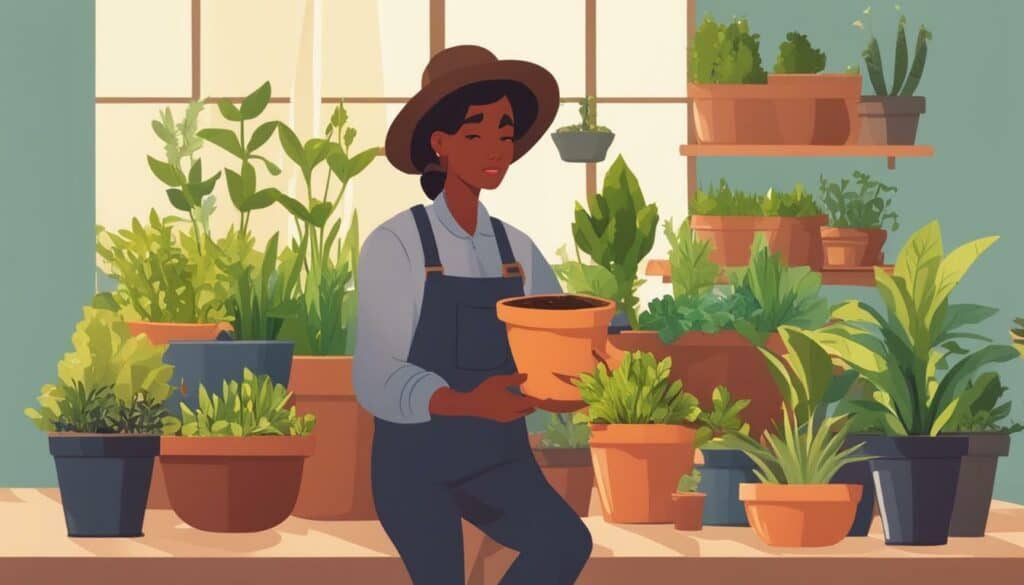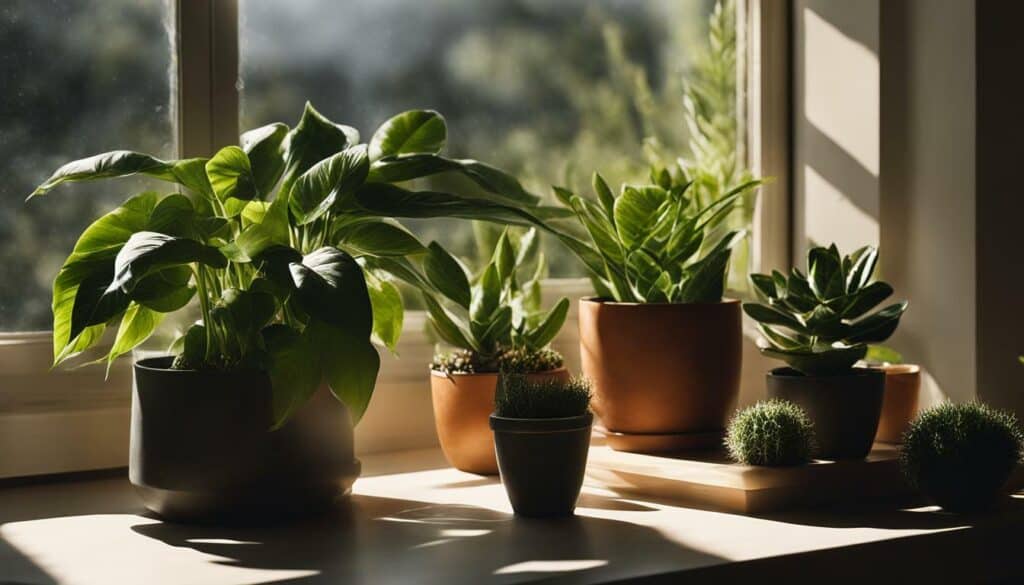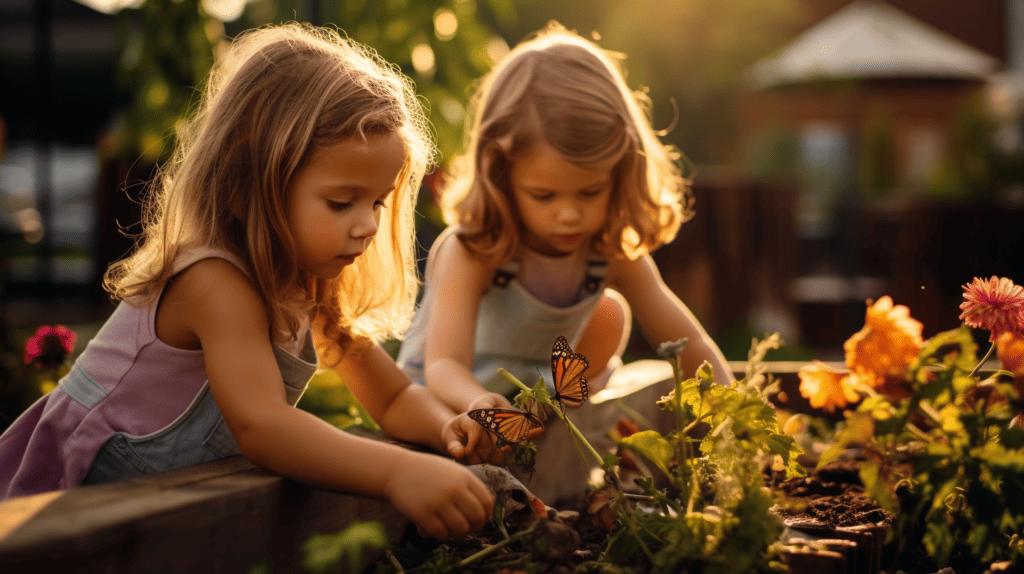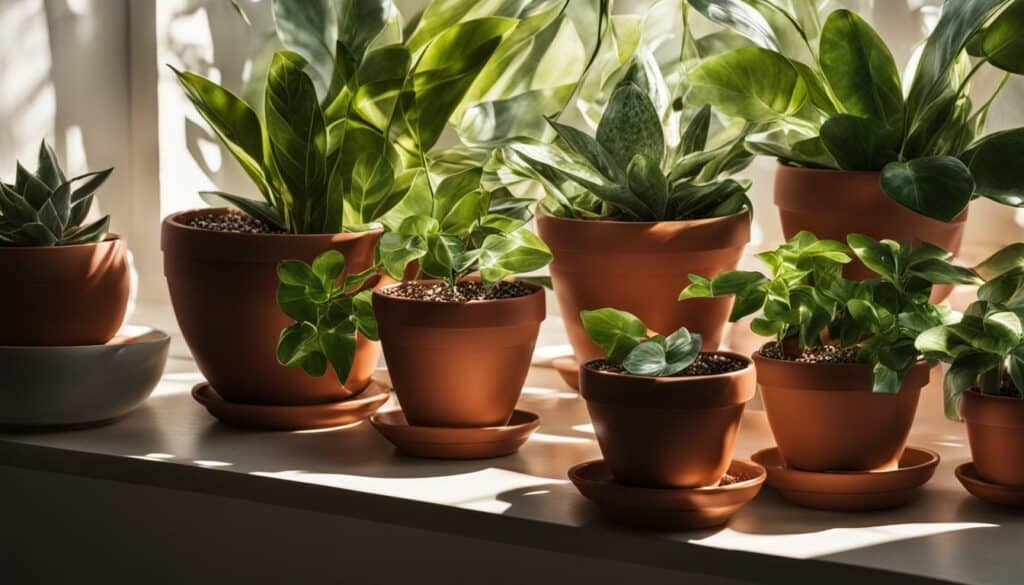Welcome to “Discovering Green Thumbs: A Guide to Plant Basics”! In this comprehensive plant care guide, we will explore the essential tips and techniques you need to know to become a successful plant parent. Whether you are new to gardening or looking to enhance your indoor plant care skills, this guide will provide you with the knowledge to nurture your plants and witness their vibrant growth.
Key Takeaways:
- Understanding plant basics is crucial for successful plant care.
- Choosing the right plants for your environment requires knowledge of plant growth stages.
- Proper watering techniques are key to maintaining healthy plants.
- Providing the right amount of sunlight is essential for healthy plant growth.
- Fertilizing and pruning are important tasks for plant nutrition and aesthetics.
- Pest prevention is crucial to maintaining healthy plants.
- Sansevieria, succulents, peace lilies, and African violets are great beginner-friendly plants.
- Considering sunlight and temperature requirements is important for indoor plant care.
Choosing the Right Plants for Your Environment
Before diving into the world of plants, it’s crucial to choose the right ones for your specific environment and gardening experience. As a beginner gardener, selecting plants that are easy to care for and match your environment is key to success. It’s important to consider factors such as sunlight and temperature requirements, as well as your own care style.
If you live in a hot region, select plants that can tolerate high temperatures and direct sunlight. For example, cacti and succulents are great for those who tend to forget watering. These plants require minimal watering and can handle bright and direct sunlight. On the other hand, if you live in a cooler climate, select plants that can survive colder winters and may require more water. African Violets and Peace Lilies are suitable for those who enjoy watering their plants more often.
Proper watering and sunlight are essential for plant health. It’s important to use pots with drainage holes to prevent overwatering and water your plants until moisture starts to drip out. When it comes to sunlight, most houseplants thrive in bright indirect sunlight, so placing them near windows is ideal. However, too much direct sunlight can lead to wilting and browning of leaves. Finding the right balance for sunlight and water is crucial for successful plant growth.
Understanding plant growth stages is also important for selecting the right plants. Some plants may require more attention in their early stages, while others may flourish as they grow. As a beginner, it’s best to select plants that are easy to care for and require minimal maintenance. Researching different types of plants and their growth stages can help you make informed decisions when selecting new plants for your garden.
By choosing the right plants for your environment and providing them with the proper amount of water and sunlight, you can create a thriving garden. Remember to consider your own care style and select plants that match your experience level. With a little bit of research and care, your green thumb will be flourishing in no time!

Watering Plants Correctly
Watering plants is one of the most vital aspects of plant care, and knowing how to do it correctly can make all the difference in the health and longevity of your green companions. When it comes to plant maintenance, it is important to choose the right plants for your environment, considering factors such as sunlight and temperature requirements. Understanding your own care style, whether you tend to forget to water or prefer to water more often, can help determine the best plants for you.
When it comes to watering, it is recommended to use a pot with drainage holes to prevent overwatering. Checking the soil before watering and watering once a week is generally sufficient for most houseplants. Overwatering can lead to root rot and ultimately kill the plant, so it is important not to water too frequently. When watering, it is a good idea to bring the plant to a sink to allow excess water to drain out.
| Type of Plant | Watering Frequency | Amount of Water |
|---|---|---|
| Succulents | Every 2-3 weeks | Small amount |
| Spider Plant | Once a week | Moderate amount |
| Peace Lily | Once a week | Large amount |
Sunlight is also crucial for plants, and most houseplants prefer bright indirect sunlight. Placing them near a window, but not right next to it, is ideal. Overexposure to sunlight can cause wilting and browning of leaves. Consider the sunlight requirements when selecting and caring for plants, especially in indoor environments.
By following these tips, you can ensure that your plants receive the correct amount of water and sunlight for optimal growth. Taking care of plants requires effort and patience, but the satisfaction of seeing them thrive is worth it. In the next section, we will discuss the impact of sunlight on plant growth stages.
Providing the Right Amount of Sunlight
Sunlight is like the life-giving energy source for plants, and getting the right amount is crucial for their overall health and development. When selecting plants for your indoor space, it’s essential to consider their sunlight requirements and choose ones that match your environment. Some plants require more direct sunlight, while others prefer indirect or shade. Care style is also an important consideration, as it can determine the frequency and amount of watering required.
If you live in an area with long, hot summers, opt for plants that can tolerate high temperatures and direct sunlight, such as succulents or cacti. However, if you live in a cooler climate, choose plants that can survive colder temperatures and may require more water, such as peace lilies or African violets.
When it comes to watering, use pots with drainage holes to prevent overwatering. Understanding your plant’s watering needs is crucial for their health and growth. Some plants, like succulents, are drought-tolerant and require less frequent watering, while others like African violets prefer more water.
Most houseplants thrive in bright indirect sunlight, so placing them near a window is ideal. However, make sure to watch out for signs that your plant is getting too much sunlight, such as wilting or browning leaves. If you notice these signs, move your plant to a spot with less sunlight or position them further away from the window.
By providing the right amount of sunlight and water, your plants will thrive. Remember to keep an eye on your plants’ growth stages and adjust their care as needed.

Providing the Right Amount of Sunlight:
| Plant Type | Light Requirements |
|---|---|
| Succulents & Cacti | Direct sunlight |
| African Violets | Indirect sunlight |
| Peace Lilies | Indirect sunlight |
Fertilizing Plants at the Right Time
Just like us, plants need proper nutrition to thrive, and providing them with the right fertilizers at the right time can work wonders for their overall health and vitality. Fertilizing plants is an essential part of plant maintenance and helps ensure their optimal growth and development.
When it comes to fertilizing, there are different types of fertilizers you can choose from. Organic fertilizers like compost and manure are popular choices and provide a slow-release source of nutrients. Chemical fertilizers are also available, and they can provide a quick boost of nutrients to your plants.
It’s important to fertilize your plants at the right time to ensure they get the nutrients they need. For most plants, the best time to fertilize is during the growing season, typically from spring to fall. During this time, plants are actively growing and need the extra nutrients to support their growth.
Before fertilizing your plants, it’s important to read the instructions on the fertilizer package carefully. Over-fertilizing your plants can cause damage, so it’s essential to apply the right amount.
Understanding your plants’ specific needs is also crucial when it comes to fertilizing. Some plants may require more frequent fertilization, while others may need less. When selecting plants, consider their nutritional needs and choose plants that fit your care style.
Finally, remember that fertilizing is just one part of plant maintenance. Providing your plants with adequate water, sunlight, and proper pruning can also contribute to their overall health and vitality.
Repotting Plants and Pruning
As your plants grow, they may outgrow their pots and require repotting, and occasional pruning can help maintain their shape and encourage healthy growth. Repotting plants is an essential aspect of plant care as it allows them to grow bigger and healthier roots. When repotting, it is important to choose a container that is slightly larger than their current one and has good drainage holes to prevent waterlogging.
Consider the environment in which your plant thrives before repotting. Factors like sunlight, temperature, and watering schedule should be taken into account, as these can impact the plant’s growth. Once you have chosen the new pot, prepare the soil by adding a layer of gravel or rocks to the bottom to help with drainage. Place fresh soil on top and gently remove the plant from its old container, being careful not to damage its roots. Place the plant in its new pot and fill in the gaps with soil, pressing down gently to remove air pockets. Water the plant thoroughly and allow it to drain before placing it in its new spot.

Pruning is another important aspect of plant care that helps keep them healthy and looking good. Pruning involves removing dead or damaged leaves, stems, and flowers to promote healthy growth. Regularly pruning your plants can also help prevent disease and insect infestations. When pruning, use clean and sharp tools to minimize damage to the plant. Cut stems at a 45-degree angle and remove any dead or damaged leaves. Prune your plants during their active growing season for the best results.
Cleaning your plant’s leaves is another essential step to maintain their health. Dust and debris can accumulate on the leaves, causing pests like spider mites and mealybugs to grow. Use a soft, damp cloth to gently wipe the leaves, making sure to remove any dust and debris that have accumulated. This will also help the plant absorb more sunlight, promoting healthy growth.
By following these plant maintenance tips, even those who have a “black thumb” can become successful gardeners. Repotting and pruning your plants, cleaning their leaves, and being mindful of their environment will help ensure their health and vitality, allowing you to enjoy their beauty for years to come.
Preventing Pests and Plant Diseases
Keeping your plants healthy and free from pests and diseases is essential for their overall well-being and longevity. As part of plant maintenance, it’s important to choose the right plants for your environment. Consider factors like sunlight and temperature requirements to ensure that your plants have the optimal conditions for growth.
Watering your plants correctly is crucial, as both overwatering and underwatering can have detrimental effects. Proper drainage is necessary to prevent plants from growing in wet soil. Providing the right amount of sunlight is also key, with different plants having different light needs. Knowing the signs of too much sunlight, such as wilting or browning leaves, can help in preventing damage.
Nurturing your plants with proper fertilization, pruning, and regular cleaning of leaves can prevent pests from growing. Pests are attracted to weak and unhealthy plants, so it is important to keep your plants healthy and strong. Treating pests early on with organic methods can prevent them from spreading and causing damage to other plants.
In addition to pests, plant diseases can also be problematic. Fungal infections, bacterial infections, and viruses can all affect plant health. Proper plant care, including regular cleaning and pruning, can prevent the spread of disease. It’s important to remove any infected or dead plant material promptly to prevent the spread of disease to other plants.
In conclusion, preventing pests and plant diseases involves proper plant care, choosing the right plants for your environment, and providing the optimal conditions for their growth. By taking these steps, you can keep your plants healthy and thriving for years to come.
Beginner-Friendly Plants for Success
If you’re just starting your plant care journey or looking for some low-maintenance companions, here are a few beginner-friendly plants that are sure to thrive under your care. These plants require minimal watering and can adapt to different sunlight and temperature conditions, making them ideal for beginner gardening.
| Plant | Light Requirements | Watering Frequency | Additional Tips |
|---|---|---|---|
| Sansevieria | Low to bright indirect light | Water when soil is dry to touch | Great air purifier, ideal for bedrooms |
| Succulents/Cacti | Bright direct light | Water sparingly, once every 2-3 weeks | Well-draining soil is essential, avoid over-watering |
| Peace Lily | Low to medium indirect light | Water when soil is dry to touch | Great air purifier, ideal for bathrooms |
| African Violets | Low to medium indirect light | Water from the bottom, keep soil moist | Avoid getting water on the leaves, use a pot with drainage holes |
Remember to closely monitor your plant’s growth and adjust your care techniques as needed. These beginner-friendly plants are just the start of your green thumb journey.

Considering Sunlight and Temperature Requirements
When it comes to plant care, understanding and meeting the sunlight and temperature requirements of your plants can make a world of difference in their overall health and happiness.
It is essential to consider the climate and location when selecting plants, especially for indoor environments. For example, plants that can tolerate high temperatures and direct sunlight are suitable for regions with long, hot summers, while plants that can survive colder winters and may require more water are ideal for cooler climates.
Another important factor to consider is your care style. For those who forget to water their plants, drought-tolerant plants like succulents or cacti are recommended. For those who water their plants more frequently, moisture-loving plants such as African Violets or Peace Lilies are suitable.
The amount of sunlight a plant receives is also crucial. Placing houseplants near a window, but not right next to it, allows them to receive plenty of indirect light. Signs of too much sunlight include wilting and browning or crispy leaves.
Proper watering is essential in addition to sunlight. Using pots with drainage holes and watering until the excess moisture starts to drip out of the pot helps prevent overwatering. By considering these factors, one can choose the right plants for their environment.

Conclusion
Congratulations! You’ve now unlocked the green thumb within you and are armed with the essential knowledge of plant basics to successfully care for your leafy companions. Throughout this guide, we covered everything you need to know about beginner gardening, from selecting the right plants for your environment to providing proper care and maintenance.
Gardening 101: A Beginner’s Guide to Cultivating Your Green Thumb is a comprehensive resource for anyone looking to start their gardening journey. The book covers various topics such as understanding soil, choosing the right plants, watering and irrigation, nurturing plants, and creating a beautiful garden.
By following the tips and techniques outlined in the book, readers will have the knowledge and confidence to create their own thriving garden. However, gardening is a continuous process, and the best way to learn is through experimentation and observation.
So, as you continue on your gardening adventure, never stop exploring and learning new ways to bring joy and beauty into your life through the wonders of nature. Gardening is a rewarding hobby that will enrich your life and the world around you.
Thank you for reading Gardening 101, and happy gardening!
What Are Some Colorful Plants I Can Grow as a Beginner Gardener?
If you’re a beginner gardener looking to add some vibrant colors to your garden, consider these suggestions for what plants for vibrant garden colors. Marigolds are easy to grow and come in various bright hues. Petunias are another popular choice, with their eye-catching blooms. For a touch of exotic beauty, try growing bougainvillea with its dazzling display of colors. Lastly, don’t forget about zinnias, which offer a wide range of shades and are incredibly resilient.
FAQ
Q: What topics does the guide cover?
A: The guide covers choosing the right plants for your environment, watering plants correctly, providing the right amount of sunlight, fertilizing plants at the right time, repotting plants, pruning, and preventing pests.
Q: What are some beginner-friendly plants suggested in the guide?
A: The guide suggests Sansevieria, Succulents/Cacti, Peace Lily, and African Violets as beginner-friendly plants.
Q: Why is considering sunlight and temperature important when selecting plants?
A: Sunlight and temperature requirements determine the success of plant growth. It’s crucial to understand these requirements to provide the optimal environment for your plants.
Q: How can I water my plants correctly?
A: The guide provides tips on determining the appropriate watering frequency and amount for different types of plants to ensure their health and vitality.
Q: How should I fertilize my plants?
A: The guide discusses the importance of plant nutrition and provides guidance on fertilizing plants at the right time using different types of fertilizers and application methods.
Q: When and how should I repot my plants?
A: The guide explains when and how to repot plants to promote their well-being and provides insights into the benefits of pruning for plant health and aesthetics.
Q: How can I prevent pests and plant diseases?
A: The guide offers tips on identifying common pests, implementing preventive measures, and using organic methods for pest control to maintain the health and vitality of your plants.
Source Links
- https://plantcareforbeginners.com/articles/houseplants-101-how-to-get-a-green-thumb
- https://www.amazon.com/Green-Thumbs-Activity-Outdoor-Gardening/dp/155652238X
- https://www.amazon.com/Gardening-101-Beginners-Guide-Cultivating/dp/B0CC7QS54Y
- https://www.amazon.com/Green-Thumb-Craig-Miller-Randle/dp/1760986461
- https://extension.okstate.edu/fact-sheets/basic-plant-care-understanding-your-plants-needs.html
- https://ag.umass.edu/landscape/fact-sheets/choosing-sustainable-plants
- https://www.fast-growing-trees.com/pages/landscape-design-101-choosing-the-right-plants
- https://bloomscape.com/plant-care/how-to-water-indoor-plants-correctly/
- https://www.bhg.com/gardening/houseplants/care/watering-houseplants/
- https://www.thespruce.com/tips-for-watering-plants-5198467
- https://aggie-horticulture.tamu.edu/ornamental/a-reference-guide-to-plant-care-handling-and-merchandising/light-temperature-and-humidity/
- https://extension.umn.edu/planting-and-growing-guides/lighting-indoor-plants
- https://www.almanac.com/how-fertilize-your-vegetable-garden
- https://www.finegardening.com/article/fertilizing-basics
- https://www.bhg.com/gardening/yard/garden-care/why-you-should-fertilize-plants/
- https://extension.uga.edu/publications/detail.html?number=C1240&title=repotting-basics
- https://www.joyusgarden.com/repotting-plants/
- https://www.thesill.com/blog/plant-care-repotting
- https://content.ces.ncsu.edu/extension-gardener-handbook/8-integrated-pest-management-ipm
- https://www.rhs.org.uk/prevention-protection/preventing-pest-and-disease-problems
- https://agroecology.ucsc.edu/resources/publications/grower-guides/pdf-downloads/pestchart.pdf
- https://bloomscape.com/plant-care/9-easiest-houseplants-anyone-can-grow/
- https://www.loveandrenovations.com/plants-for-beginners/
- https://www.amazon.com/Beginners-Houseplant-Garden-User-Friendly-Troubleshooting/dp/1580115934
- https://www.ncbi.nlm.nih.gov/books/NBK234817/
- https://www.inspiritvr.com/general-bio/plants/plant-life-cycle-study-guide
- https://www.inspiritvr.com/general-bio/plants/plant-characteristics-study-guide





Leave a Reply